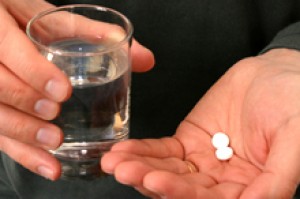Comparing Treatments for Lacunar Stroke
Comparing Treatments for Lacunar Stroke
Aspirin combined with a drug called clopidogrel is no better than aspirin alone for preventing stroke in people with a history of lacunar strokes, according to a new study. The combination also carries a greater risk of gastrointestinal bleeding.

Strokes occur when blood vessels that supply the brain rupture or become blocked. Lacunar strokes often arise from chronic high blood pressure, which leads to progressive narrowing and finally blockage of small arteries that supply deep brain structures. Lacunar strokes account for up to one-fifth of all strokes. They’re especially common among African-Americans, Hispanics and people with diabetes.
Antiplatelet drugs such as aspirin are routinely prescribed to help prevent new strokes in people with a history of lacunar stroke. These drugs interfere with the formation of blood clots that can cause strokes. Dr. Oscar R. Benavente at the University of British Columbia in Vancouver led a large trial designed to test whether aspirin plus clopidogrel (another antiplatelet drug) would offer better protection than aspirin alone. The trial also tested 2 levels of blood pressure control. It was funded in part by NIH’s National Institute of Neurological Disorders and Stroke (NINDS).
More than 3,000 people were enrolled at 82 clinical centers in North and South America and in Spain. The patients were age 30 and older, and all had a recent history of lacunar stroke. About 52% were white, 31% Hispanic and 17% black. About half received 325 milligrams of aspirin and 75 milligrams of clopidogrel daily. The other half received aspirin with an inactive placebo. Participants also received either standard control of systolic blood pressure (130-149 mm Hg) or aggressive control (less than 130 mm Hg). The results appeared in the August 30, 2012, issue of New England Journal of Medicine.
After 8 years, the aspirin-clopidogrel combination was about equal to aspirin in reducing the risk of any type of stroke. However, the combination almost doubled the risk of gastrointestinal bleeding. Deaths from any cause were also higher in the aspirin-clopidogrel group. After an interim analysis in August 2011, the antiplatelet component of the trial was stopped, and participants were encouraged to continue taking aspirin without clopidogrel. The blood pressure component of the trial is ongoing.
The results do point to an overall improvement in stroke management during the past decade. The stroke risk in both treatment groups was more than 3-fold lower than that from 10 years ago. “What we see more and more often in stroke prevention trials is a significant decrease in stroke risk, compared to data from 10 years ago,” Benavente says. “We have better medications now to control stroke risk factors such as high blood pressure and cholesterol, and these are clearly having an impact.” Doctors are also identifying and treating stroke in a timelier manner.
Current clinical practice guidelines recommend aspirin alone, clopidogrel alone, or aspirin plus dipyridamole for secondary prevention after most types of stroke. These study results are consistent with those guidelines. Researchers continue to investigate whether the clopidogrel-aspirin combination might help patients with other types of stroke.
###
* The above story is reprinted from materials provided by National Institutes of Health (NIH)
** The National Institutes of Health (NIH) , a part of the U.S. Department of Health and Human Services, is the nation’s medical research agency—making important discoveries that improve health and save lives. The National Institutes of Health is made up of 27 different components called Institutes and Centers. Each has its own specific research agenda. All but three of these components receive their funding directly from Congress, and administrate their own budgets.



















